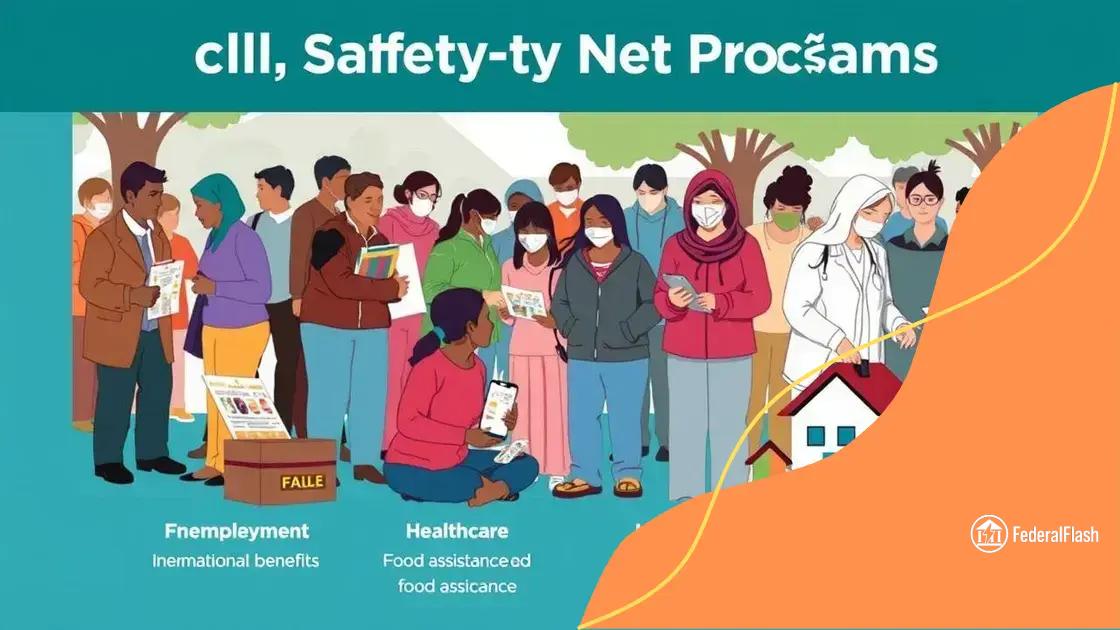Discussions about the future of work and the social safety net

Anúncios
Discussions about the future of work and the social safety net highlight the importance of adapting skills and embracing technology to thrive in an evolving job market while ensuring support for individuals facing economic challenges.
Discussions about the future of work and the social safety net are more relevant than ever. With rapid changes in technology and society, it’s crucial to understand how these factors intertwine and influence our daily lives. Let’s dive deeper into this important topic.
Anúncios
The evolving landscape of work
The way we work has changed dramatically in recent years. The landscape of work is evolving, influenced by technology, culture, and economic forces. Understanding these shifts is vital for everyone, from employers to employees.
As we explore these changes, it’s important to recognize how they shape our daily lives and routines.
Impact of Technology
One major factor in the evolving landscape of work is technology. Advances in AI, automation, and remote collaboration tools are reshaping what jobs look like. People can work from anywhere, leading to a more flexible work environment.
Anúncios
- The rise of remote work opportunities.
- Increased use of tools for communication and project management.
- Job roles adapting to new technologies.
- Opportunities for upskilling in the workforce.
This transformation affects not only how we work but also where we work. Traditional offices are being reimagined, with many companies adopting hybrid models that combine in-office and remote work.
Changing Workforce Dynamics
The workforce dynamics are also shifting. Younger generations prioritize job flexibility and work-life balance over job security. This new perspective challenges traditional career paths and encourages a culture of continuous learning.
- Focus on personal well-being and mental health.
- Value placed on meaningful work and corporate social responsibility.
- Emergence of gig economy jobs.
- Shift towards project-based work rather than lifelong careers.
These changes present unique challenges and opportunities for both employees and employers. Organizations must adapt to attract and retain talent that values flexibility and purpose in their work.
In conclusion, the landscape of work is continuously evolving due to technological advancements and changing workforce attitudes. By staying informed and adaptable, we can better navigate these changes and harness the opportunities they bring.
How automation affects job security
As we dive into how automation affects job security, it’s clear that automation is reshaping the workforce. Many tasks traditionally performed by humans are now being handled by machines and software, which raises questions about job stability.
Automation is not just about robots on assembly lines; it’s also about software performing administrative tasks faster and more accurately than humans. This shift can lead to job displacement in certain sectors, leaving workers anxious about their futures.
Job Displacement
One significant impact of automation is the potential for job displacement. Certain roles, especially those that involve repetitive tasks, are more vulnerable. Workers in sectors such as manufacturing, retail, and customer service might find their jobs at risk due to increased automation.
- Manufacturing jobs replaced by robots.
- Customer service roles diminished by chatbots.
- Administrative positions reduced due to automated systems.
- Transport jobs affected by self-driving technology.
However, it’s essential to recognize that while some jobs may disappear, new opportunities can arise. The demand for positions in technology, programming, and maintenance of automated systems is on the rise.
New Opportunities
As automation takes over certain tasks, new job categories are emerging, requiring different skills. For instance, workers will need to adapt to technology by learning how to work alongside automated systems.
- Growth in tech-related fields.
- Demand for skilled workers in data analysis.
- Increased need for technical support roles.
- Upskilling and reskilling of displaced workers.
Automation can also enhance productivity, making businesses more efficient. This increase in efficiency can lead to economic growth, potentially creating more jobs in the long run. Therefore, understanding how to manage this transition is crucial for both employees and employers.
The role of the social safety net

The role of the social safety net is crucial in today’s society, especially as we face rapid changes in the job market. These programs provide support to individuals facing financial hardships, such as unemployment, sickness, and poverty, helping them navigate through tough times.
The social safety net includes various government programs designed to assist those in need. These programs are vital for maintaining stability and ensuring that people can meet their basic needs.
Types of Social Safety Nets
There are several types of social safety net programs that play a significant role in supporting vulnerable populations. These programs aim to prevent people from falling into extreme poverty.
- Unemployment benefits: These provide temporary financial assistance to individuals who have lost their jobs.
- Food assistance: Programs like SNAP help families access nutritious food.
- Health care assistance: Programs like Medicaid offer health care coverage to low-income individuals.
- Housing support: Rental assistance programs help families afford stable housing.
These services are not just safety measures; they also encourage individuals to seek new job opportunities and improve their skills without the immediate stress of financial insecurity.
The Importance of a Strong Safety Net
A robust social safety net can stimulate economic growth. When people have access to support, they are more likely to invest in education and training. This investment helps them enter the workforce with better skills and a greater chance of success.
Moreover, during economic downturns, a strong social safety net can help stabilize the economy by maintaining consumer spending. Individuals with access to these programs can continue to purchase goods and services, which supports local businesses.
In summary, the social safety net is vital for encouraging stability and resilience in the workforce. Its benefits extend beyond individuals, fostering a healthier economy and a more equitable society.
Innovative solutions for future challenges
In today’s fast-paced world, finding innovative solutions for future challenges is essential for both individuals and organizations. With the rapid evolution of technology and shifting social dynamics, new approaches are needed to navigate the complexities of modern life.
Innovation plays a key role in addressing issues such as job displacement due to automation and the adequacy of the social safety net. Creative problem-solving can lead to more effective policies and practices that benefit everyone.
Embracing Technology
One approach is to embrace technology to create solutions that enhance productivity and support workers. For instance, upskilling programs use online platforms to help workers learn new skills that are in demand.
- Online learning allows flexible access to education.
- Companies can partner with educational institutions to provide targeted training.
- Gamification in training increases engagement and retention.
- Virtual reality can simulate real-world experiences for hands-on learning.
By investing in technology, not only do organizations foster a more skilled workforce, but they also create a culture of continuous improvement.
Collaboration Across Sectors
Another innovative solution involves collaboration between various sectors. Governments, businesses, and non-profits can work together to create comprehensive strategies to support communities facing challenges.
For example, initiatives that promote community-driven innovation can empower individuals to develop solutions that address local issues. These approaches can include:
- Funding for community projects.
- Workshops that gather input from diverse stakeholders.
- Encouraging local entrepreneurship through grants.
- Support networks for sharing resources and ideas.
Engaging various sectors ensures that solutions are relevant, effective, and sustainable. Such collaboration brings diverse perspectives and expertise to the table, leading to better outcomes for all involved.
By harnessing technology and promoting collaboration, we can create innovative solutions that will prepare us to face future challenges head-on. These efforts will help build a resilient society that thrives amidst change and uncertainty.
What individuals can do to adapt
As changes in the job market continue, knowing what individuals can do to adapt is crucial for success. Adapting to new circumstances requires a proactive approach and a willingness to learn new skills.
One effective strategy is to embrace lifelong learning. Staying updated with industry trends and new technologies can provide a competitive edge in the job market.
Building New Skills
Individuals should focus on developing new skills that are in high demand. This can involve taking courses, attending workshops, or using online platforms to gain knowledge.
- Identify skills that align with industry needs.
- Utilize online resources like MOOCs (Massive Open Online Courses).
- Participate in certifications relevant to your career.
- Engage in hands-on projects to apply new knowledge.
By investing in education and training, workers can enhance their employability and adapt to the changing landscape of work.
Networking and Collaboration
Another essential aspect of adaptation is building a strong professional network. Connecting with others in your field can provide valuable insights into job opportunities and industry trends.
Participation in workshops, local events, and online forums can improve your visibility and lead to meaningful collaborations. Engaging with mentors can also provide guidance and support during transitions.
- Attend industry-related events to meet professionals.
- Join online communities or forums related to your field.
- Seek mentorship to gain perspective and advice.
- Collaborate on projects that enhance your portfolio.
Adapting to a changing work environment is an ongoing process that requires resilience and flexibility. Individuals who take proactive steps to enhance their skills and build relationships in their industries are better positioned to succeed.
FAQ – Frequently Asked Questions about Adapting to the Future of Work
How can lifelong learning help me adapt to changes in the job market?
Lifelong learning keeps your skills current and relevant, making you more competitive in a rapidly changing job market.
What are some effective ways to build my professional network?
You can build your network by attending industry events, participating in online communities, and connecting with peers through social media.
Why is it important to embrace new technologies?
Embracing new technologies can enhance your efficiency, improve your job performance, and help you adapt to the evolving demands of your role.
What steps can I take to collaborate effectively with others?
To collaborate effectively, communicate openly, share resources, and actively participate in team projects to leverage collective strengths.